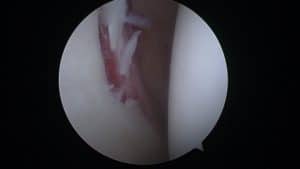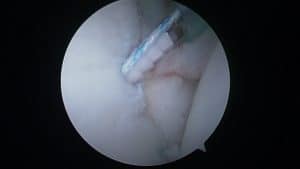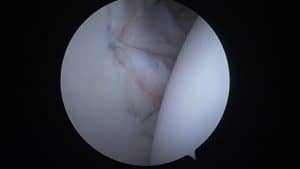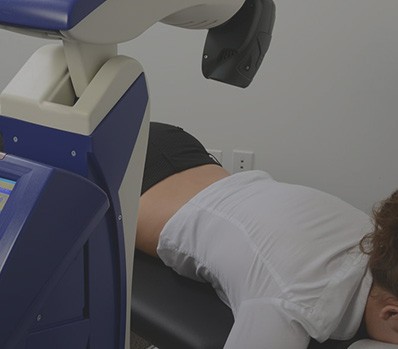Your shoulder is the most flexible joint in your body. It allows you to place, bend and rotate your arm in many positions and perform hundreds of everyday tasks — from extending your arms above your head to swimming or making a winning basketball shot. However, it is this flexibility that makes your shoulder susceptible to an array of injuries and problems.
Dr. Paul Nitz has been providing patient care at Orthopaedic Institute of Dayton and various sports medicine centers for nearly 30 years. Through comprehensive diagnosis, it is possible to determine the best treatment option to help you get back to the activities you enjoy.
Understanding the Anatomy of the Shoulder

The shoulder is made of three bones: the upper arm (humerus), shoulder blade (scapula) and the collarbone (clavicle). Two of these bones work as a ball-and-socket joint: the head of the upper arm bone fits into the shallow socket (called the glenoid) in the shoulder blade. This forms the shoulder joint called the glenohumeral joint. Articular cartilage on the head of the upper arm bone and synovial membrane on the shoulder joint allow the shoulder to move smoothly.

The upper part of the shoulder blade (known as the acromion) projects over the shoulder joint. One end of the collarbone is joined with the shoulder blade by the acromioclavicular joint or AC joint. The other end of the collarbone is joined with the breastbone or sternum by the sternoclavicular joint. A group of muscles and tendons, known collectively as the rotator cuff, attach your upper arm to your shoulder blade and help keep your shoulder in its place.
All of these structures allow the shoulder to rotate with a greater range of motion than any other joint in the body.
Causes of Shoulder Pain and Injury

Pain and injury in the shoulder could be a result of a wide range of sports or work-related injuries. Or they may be due to a degenerative disorder or overuse. Common conditions and injuries include the following:
- Neuropathy (nerve injury)
- Fractures and dislocations
- Osteoarthritis
- Shoulder disorders
- Tendon injuries
- Tendonitis
- Limited mobility
- Joint pain and stiffness
- Complications from previous shoulder surgery
Non-Surgical and Surgical Treatment Options
The first step in determining the best course of treatment is an in-person evaluation. Dr. Nitz will review your medical history and conduct a physical exam. He may take X-rays and recommend additional testing, such as MRI, CT, bone scan and nerve tests to determine the extent of injury and the most appropriate treatment option.

When appropriate, Dr. Nitz may recommend treating the injury or condition non-surgically. Treatments such as anti-inflammatory medications, injections, physical therapy and/or laser therapy may be effective in relieving chronic joint pain caused by overuse. Making modifications in physical activities and/or undergoing physical therapy may also help. Surgery may become necessary if conservative, non-surgical treatments have been attempted unsuccessfully or are determined to be inappropriate in providing pain relief or return to normal functioning. Surgery is commonly performed to:
- Repair the rotator cuff. Surgery involves repairing torn tendons in the shoulder.
- Repair shoulder instability. This occurs when the lining of the shoulder joint (capsule), ligaments or labrum has stretched, torn or detached, causing the head of the shoulder joint to move partially or completely out of socket.
- Replace the shoulder. During surgery, damaged areas of the shoulder are replaced with prostheses.
- Reduce excessive pressure in the shoulder. The offending bone spurs, calcium deposits and inflamed bursa tissue are removed.
Surgical Technique: FiberTak® Instability Repair
Reverse Total Shoulder Replacement with Univers Revers™ System
Rotator Cuff Repair with SpeedBridge™ Technique
SpeedBridge RCR
Virtual Implant Positioning™ (VIP) System
Dr. Nitz is able to perform most shoulder surgeries arthroscopically. Arthroscopy is a minimally invasive approach that allows him to visualize, diagnose and treat problems inside a joint. During surgery, tiny surgical instruments that contain a small lens and lighting system are inserted through an incision in the surgical site. The lens and lighting system magnify and illuminate the structures inside the joint, allowing Dr. Nitz to perform the surgery with enhanced precision and less damage to the surrounding healthy tissue. Arthroscopy is highly safe and successful. Most arthroscopic surgeries are performed on an outpatient basis.
For more information on shoulder injuries and effective treatment solutions, schedule a personal consultation with Dr. Nitz by calling or emailing our office today.

